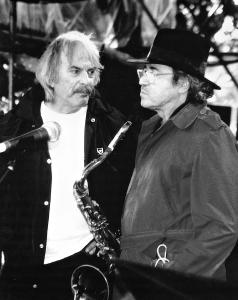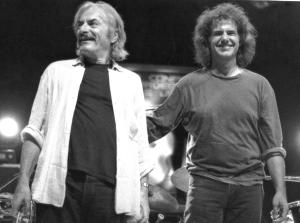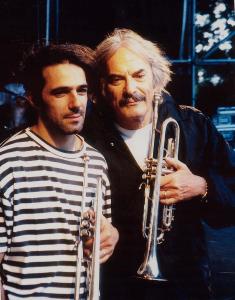On the Road with JazzPar Prize Winner Enrico Rava
by Mitchell FeldmanAlthough a light rain dampened outdoor festivities surrounding the 62nd birthday of Queen Margarethe II of Denmark on April 16, it didn't faze workers at Tivoli who were busy getting the rides and other attractions at the world's oldest amusement park ready for the 2002 season scheduled to open later in the week.
In a restaurant attached to the Glass Hall, a theatre on Tivoli's grounds, Italian jazz trumpeter Enrico Rava was fielding questions at a press conference kicking off the week of activities associated with his having won the JazzPar Prize, a Danish cultural award nicknamed "the Nobel Prize of Jazz" that since 1990 has annually acknowledged the creative contributions of a prominent jazz artist.
Rava is the first Italian, fifth European and thirteenth recipient of the honor that comes along with a two-concert tour of northern Denmark, two shows at Tivoli and a 200,000 krone (roughly $25,000) honorarium. "I've won lots of awards in my lifetime but it's nice to get one with some bread attached to it for a change," the trumpeter, who bears a striking resemblance to the character Zonker in Garry Trudeau's comic strip "Doonesbury," joked. His quip elicited hearty laughs from the assembled journalists, officials and sponsors well aware that jazz has historically been treated as the Cinderella of the fine arts.
Rava's weeklong stay in Denmark ended April 21 when he was given the JazzPar award, a bronze replica of a sculpture by Jorgen Haugen Sorrensen on permanent display in Tivoli upon whose base the trumpeter's name was inscribed along with those of previous prize winners. It was the crowning moment in a memorable month for the 62-year-old Trieste native who has enjoyed the highest international profile of any Italian jazz artist since emerging on the international jazz scene in the late 1960s.
Right after Easter Rava was notified that he'd been named a Chevalier des Arts et Lettres by the Republic of France although, unlike the JazzPar prize, inserted along with the letter announcing this award was a note listing the name and address of the official outfitter in Paris where he could purchase his decoration.
Rava's wife Lidia Panizzut, who like her husband sports a striking mane of shoulder-length gray hair, accompanied the trumpeter to Denmark. Since she doesn't travel by air they made the entire journey from their home in S. Andrea di Roveretto to Copenhagen by train, a trip that took 26 hours. Panizzut met Rava in the mid '80s when she was managing the Scimmie jazz club in Milan and has been immortalized by her husband in his tune "Song For Jessica."
Enrico Rava & Gato Barbieri during a soundcheck at Umbria Jazz 2001 in Perugia, Italy, during their "Complete Reunion" Tour. Photo Credit: Mitchell Feldman He didn't forget her name. The song is actually from his recording Noir, a musical tribute to Raymond Chandler, Dashiell Hammett, Simenon and other authors whose fiction Rava admires and the CD includes a comic book drawn by the popular Italian cartoonist Altan and Lidia was the inspiration for the character Jessica Tatum, a crime-fighting D.A. who used to be a cigarette girl at the Parisian jazz club Duc du Lombard.
Rava began playing the trombone in Dixieland bands when he was 15 and switched to trumpet at 18 after hearing Miles Davis perform in Turin where moved with his family in 1943. Soon he was getting asked to participate in local jam sessions and in 1963 the Argentine saxophonist Gato Barbieri, who was living in Rome, convinced Rava to join him there. The two honed their skills at a nightly gig that lasted nine months at Meo Patacca, a popular restaurant in Trastevere owned by the expatriate American character actor Remington Olmstead.
After Barbieri moved to Paris Rava joined American saxophonist Steve Lacy's quartet which led to extended stays in London, South America and eventually New York. Welcomed into the free jazz scene flourishing in Manhattan in the late 1960s, Rava returned to Europe for a year to secure a green card and then relocated to New York in 1969 where he remained until 1978.
In the quarter century since returning to Italy, Rava has mellowed like a fine wine. No longer an avant garde avatar, today he is more likely to be heard playing jazz interpretations of the opera "Carmen" or of the themes to award-winning Italian films like "Il Postino," "Mondo Cane" and "La Dolce Vita." The trumpeter is arguably at the peak of his career today with his programs featuring the music of cool jazz masters like Chet Baker and Miles Davis, Rava's main idols, among the most popular events on the European jazz festival circuit during the past two years and he was showcased leading four different formations on four separate nights in a mini career retrospective at the 2001 Montreal Jazz Festival last July (One of these nights, his Miles tribute with the Sardinian trumpeter Paolo Fresu, was just released by France's Label Bleu, the first in a series of CDs that will document the Montreal engagements). Later that month a concert with Pat Metheny at the Between the Borders of Sardinia & Jazz Festival in Sant'Anna Arrese was ranked by both artists as one of their finest in recent memory. On June 1 he will return to North America to appear the 2002 San Francisco Jazz Festival, having last performed in the US in January 2001 when he headlined an Italian Jazz All-Stars concert Umbria Jazz presented at New York's Town Hall in conjunction with the annual convention of the International Association of Jazz Educators convention being held there.
Enrico Rava & Pat Metheny after their collaboration at the 2001 Between The Borders of Sardinia & Jazz Festival in Sant'Anna Arrese, Italy. Photo Credit: Agostino Mela Rava performed in Denmark with a special sextet he assembled for the JazzPar tour which included two members of his current quintet -- pianist Stefano Bollani and trombonist Gianluca Petrella, two of the brightest young stars on the current Italian jazz scene -- and an old friend, the American guitarist John Abercrombie who first played with Rava in a quartet the trumpeter led in 1973. Bassist Jesper Bodilsen and drummer Morten Lund, two of Denmark's leading jazz artists who often back big name musicians who come to Copenhagen, completed the line-up.
After two days of rehearsals at Danish Radio's studios, Rava's band, the opening group on the tour -- an octet led by the Danish saxophonist Thomas Agergaard that featured bassist Miroslav Vitous, drummer Jim Black and cellist Hank Roberts -- as well as JazzPar staff, a technical crew and various invited guests boarded a chartered bus which traveled to Randers and Vejle, cities on the Jutland peninsula founded in the 14th century, where the Tivoli program was previewed before enthusiastic crowds. Rava's song list featured some of his earlier works, a couple of popular jazz standards and several new tunes he composed for the tour that the band fine-tuned on the road before returning to Copenhagen.
Enrico Rava and Paolo Fresu at the soundcheck before their tribute to Miles Davis at the 2001 Umbria Jazz Festival in Perugia, Italy. Photo Credit: Mitchell Feldman After performing at Tivoli's Glass House last Saturday night, the stated time for the award presentation concert there on Sunday afternoon finally arrived. People had come to the park in droves, taking advantage of spring-like temperatures that had arrived over the weekend with the emergence of a bright sun that hadn't shone all week. The Italians forgot the fact that they hadn't had a decent cup of coffee or plate of pasta in far too many days and played an inspired set. Rava quit smoking cigarettes a few years ago after a serious case of bronchitis -- he used to consume two to three packs a day -- and as a result he has more wind at his disposal to power his playing. In addition, a mouthpiece he started using a couple of years ago has noticeably increased his range. "I finally found an old Heim mouthpiece that had not been made in something like 40 years which I had been looking for all my life. Miles used the same version but that's not the reason I use it. I knew from its characteristics that if was tailor made for the contours of my mouth and it's enabled me to hit higher notes than ever before."
Before Rava's concert, former Danish Prime Minister Poul Nyrup Rasmussen handed him his prize. After an amusing moment when the trumpeter strained to reach a microphone that had yet to be lowered from the height of a typical Scandinavian to accommodate of a Mediterranean, his voice choked as he graciously accepted the highest accolade someone in his profession can receive and dedicated his prize to his wife. Then Rava added: "I've fond memories of Copenhagen. I only played here twice before, in the old Montmartre jazz club, but I came here on a school trip when I was 12 or 13 years old and lived with a local family for two weeks. It was not only my first visit to a foreign country but I had my first girlfriend here."
Near the end of his concert Rava joked that the last time he'd worn the silk tie around his neck was at his wedding to Lidia 10 years earlier. He then introduced one of the songs he'd written for the JazzPar tour, "Happiness Is To Win A Big Prize," to the delight of the crowd. Called back for an encore by a standing ovation he launched into a swinging version of "Dear Old Stockholm," a favorite standard in the repertoire of two jazz greats -- Stan Getz and Davis -- which Rava renamed "Dear Old Copenhagen" for the occasion.
Mitchell Feldman, an American freelance writer living in Italy, is a European correspondent for Down Beat and a contributor to the International Herald Tribune supplement Italy Daily, Musica Jazz, JazzIt and All About Jazz-Italy among other publications.
C o m m e n t s
No comments yet. You can be the first.
[<<] [<] [>] [>>]




